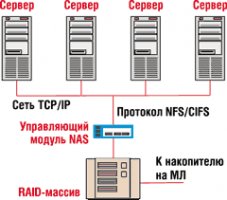Network Data Storage Technologies
 The development of modern storage systems is increasingly centralizing data storage. Examples of applications requiring a centralized repository include, for example, corporate databases, enterprise resource planning systems (Enterprise Resource Planning, ERP), postal systems, decision support systems (Decision Support Systems, DSS) and customer relationship management (Customer Relationship Management, CRM).
The development of modern storage systems is increasingly centralizing data storage. Examples of applications requiring a centralized repository include, for example, corporate databases, enterprise resource planning systems (Enterprise Resource Planning, ERP), postal systems, decision support systems (Decision Support Systems, DSS) and customer relationship management (Customer Relationship Management, CRM).
We note that the concept of the storage devices connected to the network is far from new. In particular, it is based on development such as the NFS Network File System (Network File System) of Sun Microsystems (NFS) which allows networked computers to use system resources more effectively.
The NAS architecture (Figure 1, 2) is optimized so that the systems based on it have an advantage over the general-purpose servers, at both cost and productivity. In fact, these systems are servers that perform only one function, the file service, but they do it very well. Such " fine " files are otherwise referred to as filers (filers). NAS is a high-produced platform-dependent data storage technology. Failers are simple to the administration and are easily connected to the network, providing customers with direct access to their resources. They are particularly useful in a complex heterogeneous environment where clients and servers operate under the management of different LOs.

Rhys. 2. Typical NAS topology.
The key feature of the filers is a multi-protocol file separation mechanism. They use standard communication protocols and web interfaces that allow data to be transmitted both in LAN and WAN Wednesday. Usually supported:
- Common Internet File System (CIFS) - for Microsoft Windows 9x/NT clients;
- NCP - for Novell NetWare;
- NFS - for UNIX clients;
- HTTP - for Web browser;
- DHCP for automatic IP addresses;
- SNMP - for management and monitoring.
Some filers also use the Data Management Protocol Network (NDMP), which allows for remotely backup from the disk to the magnetic tape. Fast/Gigabit Ethernet, FDDI and ATM are mainly used from network technologies.









